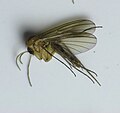Mycetophilidae
| Mycetophilidae | |
|---|---|

| |
| Exechia spinuligera | |
| Scientific classification | |
| Domain: | Eukaryota |
| Kingdom: | Animalia |
| Phylum: | Arthropoda |
| Class: | Insecta |
| Order: | Diptera |
| Infraorder: | Bibionomorpha |
| Superfamily: | Sciaroidea |
| Family: | Mycetophilidae Newman, 1834 |
| Genera | |
|
See text | |
| Diversity | |
| ca. 150 genera | |

The Mycetophilidae are a family of small flies, forming the bulk of those species known as fungus gnats. About 3000 described species are placed in 150 genera, but the true number of species is undoubtedly much higher. They are generally found in the damp habitats favoured by their host fungi and sometimes form dense swarms.[1]
Adults of this family can usually be separated from other small flies by the strongly humped thorax, well-developed coxae, and often spinose legs, but identification within the family between genera and species generally requires close study of microscopic features such as subtle differences in wing venation and variation in chaetotaxy and genitalia. The terrestrial larvae usually feed on fungi, especially the fruiting bodies, but also spores and hyphae, but some species have been recorded on mosses and liverworts. The larvae of some species, while still being associated with fungi, are at least partly predatory. Some species are attracted to the fungus smell of Jack-in-the-Pulpit, fall into their inflorescences and accomplish their pollination.
Bioluminescence
Around a dozen mycetophilid species are unique among flies in displaying bioluminescence.[2] In some species, this is restricted to the larval stage, but in others this feature is retained by the pupae and adults. The ability to produce their own light may be used by some predatory larvae as a lure for potential prey, although it also obviously makes them more susceptible to predation or parasitism. These are not mycetophilids sensu stricto, but belong to the family Keroplatidae.
Fossil record
Mycetophilids, including some extant genera, are well represented in amber deposits and the group appears to have been well established and diversified by the Cretaceous period at the latest.
Taxonomy
Some 800 species (including some of the bioluminescent species) have been split into a separate family by Tuomikoski in 1966, Keroplatidae. This split is not universally recognized as yet, and many sources still include the keroplatid genera within the Mycetophilidae. Other recent families, included here in Mycetophilidae as they are not recognized by all workers are Ditomyiidae, Lygistorrhinidae, Diadocidiidae, and Rangomaramidae. The Mycetophilidae sensu lato contain about 330 described genera. These include:[1][3][4]
Gallery
-
Mycetophila fungorum (De Geer, 1776)
-
Neoempheria pictipennis (Haliday, 1833)
-
Mycetophila sp.
-
Leia sp., male
-
Sceptonia sp.
-
Trichonta sp.
-
Phronia sp., female
-
Phronia male inside Jack in the pulpit flower
-
Trichonta inside Jack in the pulpit flower
Catalogues
- Evenhuis, N. L. 2006. Catalog of the Keroplatidae of the World (Insecta: Diptera). Bishop Museum Bulletin in Entomology 13. Bishop Museum Press, Honolulu. 1–178.Online here
References
- ^ a b Loïc Matile (1999-09-20). "10. Family Mycetophylidae". Australasian/Oceanian Diptera Catalog — Web Version.
- ^ John M. Sivinski (1998). "Phototropism, bioluminescence and the Diptera" (PDF). Florida Entomologist. 81 (3). The Florida Entomologist, Vol. 81, No. 3: 282–292. doi:10.2307/3495919. JSTOR 3495919.
- ^ "Mycetophilidae". Fauna Europaea. 2004.
- ^ "Nomina - Diptera: M-P". Nearctica. 1998. Archived from the original on 2011-01-14.
- ^ Meunier, F. (1904). "Monographie des Cecidomyidae, des Sciaridae, des Mycetophilidae et des Chironomidae de l'ambre de la Baltique". Ann.Soc. Sci. Brux. (Mem.). 28: 12–92, 93–275.
External links
- Fungus Gnats Online
- Diptera.info Images








